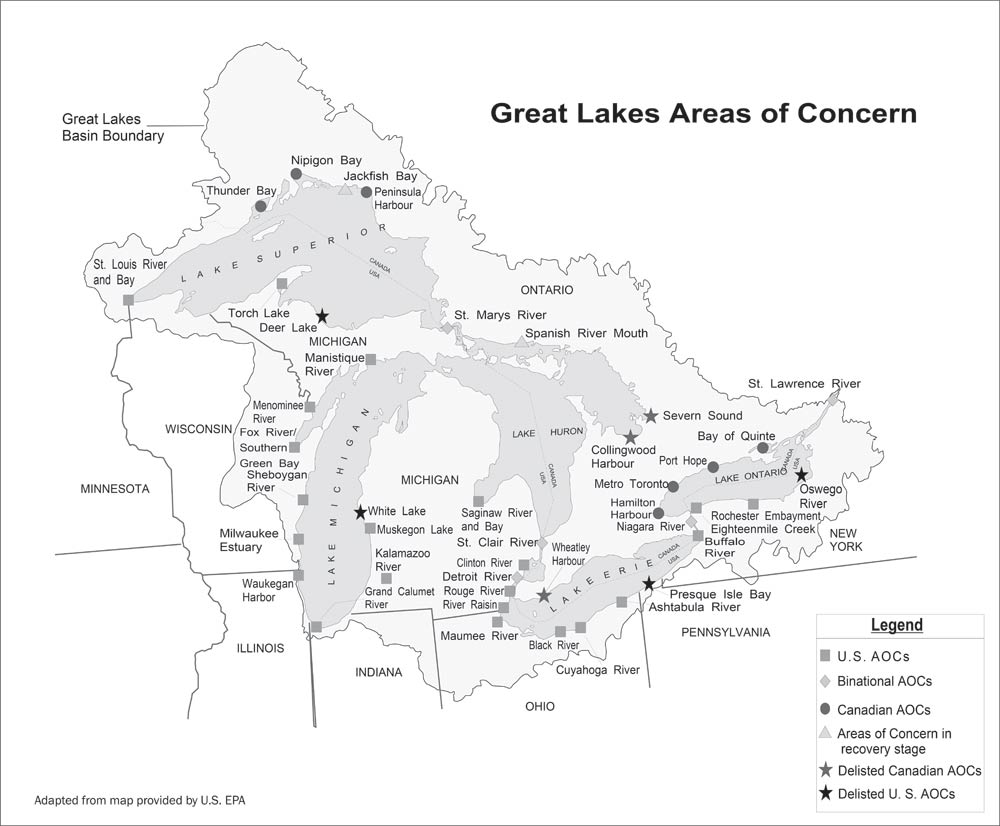- Home
- AOC
Evaluating Great Lakes Area of Concern Restoration
What have we achieved and learned after more than 30 years of Remedial Action Plans to restore Great Lakes Areas of Concern?
In 1985, the eight Great Lakes states, Ontario, and the U.S. and Canadian federal governments committed to developing and implementing comprehensive remedial action plans (RAPs) to restore impaired beneficial uses in Great Lakes Areas of Concern (AOCs). In 1987, this commitment was codified in a Protocol to the Canada-U.S. Great Lakes Water Quality Agreement.
In 2017, a symposium titled “Restoring Great Lakes Areas of Concern” was convened at IAGLR's Conference on Great Lakes Research in Detroit. Twenty-seven papers and five posters were presented at the symposium, which was sponsored by the Aquatic Ecosystem Health & Management Society, IAGLR, the International Joint Commission, the Great Lakes Commission, and the Detroit River International Wildlife Refuge.
In 2018, the Fred A. and Barbara M. Erb Family Foundation provided a two-year grant to IAGLR to help review and evaluate what has been achieved and learned in more than 30 years of AOC cleanup efforts. Specific deliverables include:
- Publish selected papers from the AOC Symposium in a special issue of AEHMS
- Prepare a science transfer report that helps sustain cleanup efforts in AOCs
- Publish an edited book based on the symposium in the Ecovision World Monograph Series of AEHMS
- Prepare a review article for the Journal of Great Lakes Research
- Undertake education and outreach
Billions of dollars have been spent in the last 30 years on restoring Great Lakes AOCs. IAGLR’s and AEHMS’s long-term commitment to science and science-transfer make them uniquely qualified to perform this 30-year evaluation and share what has been learned world-wide.

AOCs in the U.S.-Canada Great Lakes Basin Ecosystem. Adapted from a map provided by the U.S. EPA
Publications
Thirty-five years of restoring Great Lakes Areas of Concern: Gradual progress, hopeful future. Journal of Great Lakes Research, 46:3 (2020)
Great Lakes Revival: How Restoring Polluted Waters Leads to Rebirth of Great Lakes Communities (Full report) (2019) (Report highlights)
Restoring Great Lakes Areas of Concern: 32 Years of Remediation and Restoration. [Special issue]. Aquatic Ecosystem Management and Health, 21:4. (2018)
Case Studies
- River Raisin Area of Concern
- Detroit River Area of Concern
- Severn Sound Area of Concern
- Collingwood Harbour Area of Concern
- Hamilton Harbour Area of Concern
- Muskegon Lake Area of Concern
- Cuyahoga River Area of Concern
- Buffalo River Area of Concern
- St. Louis River Area of Concern
- Toronto & Region Area of Concern
News
- Toronto – A North American Leader in Waterfront Revitalization, Great Lakes Now (1/9/2019)
- From Burning River to Catalyst for Economic Revival – The Buffalo River Story, Great Lakes Now (12/17/2018)
- Areas of Concern: Turning Hot Spots Into Valuable Community, Ecological, and Economic Assets, Current (Fall/Winter 2018)
- Shared Waters: Restoring the Hamilton Harbour Watershed, Great Lakes Now (10/9/2018)
- Lessons Learned from Restoring Great Lakes Areas of Concern, Great Lakes Connection (7/3/2018)
- Transforming Great Lakes Pollution Hot Spots into Gathering Places for People and Wildlife, The Nature of Cities (12/6/2017)
IAGLR News Releases
- Great Lakes cleanup leads to community and economic revitalization (8/13/2019)
- Harbor cleanup drives Toronto’s waterfront revitalization (1/3/2019)
- A river’s remarkable ecological recovery drives economic benefits for Detroit (7/16/2018)
- River Raisin case study released (6/15/2018)
- IAGLR to evaluate Great Lakes restoration with Erb Family Foundation support (12/21/2017)
Contact
Dr. John Hartig
Great Lakes Science-Policy Advisor
[email protected] | Bio
The International Association for Great Lakes Research is a U.S. 501(c)(3) and Canadian nonprofit organization.
© 2024 International Association for Great Lakes Research

